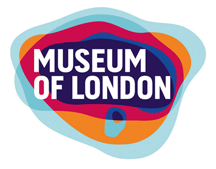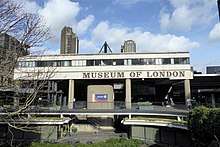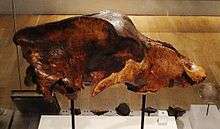Museum of London
The Museum of London documents the history of the UK's capital city from prehistoric to modern times and is located in the City of London on the London Wall, close to the Barbican Centre and is part of the Barbican complex of buildings created in the 1960s and 1970s to redevelop a bomb-damaged area of the City.
 | |
 | |

| |
| Established | 1976 |
|---|---|
| Location | London Wall London, EC2 United Kingdom |
| Visitors | 694,596 (2018)[1] |
| Director | Sharon Ament |
| Public transit access | Barbican; St. Paul's |
| Website | museumoflondon.org.uk |
The museum is a few minutes' walk north of St Paul's Cathedral, overlooking the remains of the Roman city wall and on the edge of the oldest part of London, now its main financial district. It is primarily concerned with the social history of London and its inhabitants throughout time. The museum is jointly controlled and funded by the City of London Corporation and the Greater London Authority.
The museum is the largest urban history collection in the world, with more than six million objects.[2]
In March 2015, the museum announced plans to move from its Barbican site to nearby Smithfield Market. The move, contingent upon raising an estimated £70 million, is planned to be complete by 2021.[2]
Description
The amalgamation of the collections previously held by the City Corporation at the Guildhall Museum and of the London Museum, which was located in Kensington Palace, was agreed in 1964.[3] The Museum of London Act, allowing for the merger, was passed in the following year.[4][5]
The museum was opened in December 1976 as part of the Barbican Estate.[3] The architects were Philip Powell and Hidalgo Moya,[3] who adopted an innovative approach to museum design, whereby the galleries were laid out so that there was only one route through the museum – from the prehistoric period to the modern galleries.
The museum comprises a series of chronological galleries containing original artefacts, models, pictures and diagrams, with a strong emphasis on archaeological discoveries, the built city, urban development and London's social and cultural life, with interactive displays and activities for all ages. Fragments of the Roman London Wall can be seen just outside the museum.
.jpg)
The museum had a £20 million redevelopment which was completed in May 2010. This was its biggest investment since opening in 1976. The re-design, by London-based architects Wilkinson Eyre, tells the story of London and Londoners from the Great Fire of 1666 to the present day. The transformation includes four new galleries. The new City Gallery features large street level windows along London Wall and provides an illuminated showcase for the Lord Mayor's State Coach, which takes to the streets each November for the Lord Mayor's Show.
The Galleries of Modern London increased the museum's exhibition space by 25 percent and enabled the display of 7,000 objects. Star exhibits include a reconstruction of Georgian pleasure gardens, the foreboding wooden interior of the Wellclose debtors prison cell, an art deco lift from Selfridges department store and the puppet stars of BBC children's TV Andy Pandy and Bill and Ben.
The "Expanding City" gallery covers the period 1660s to 1850. "People's City" addresses 1850 to 1940s, including a "Victorian Walk" with recreated shops and public buildings, and sections on the West End, Suffragettes, World War I and World War II, and everyday life.
The new galleries place a renewed emphasis on contemporary London and contemporary collecting. "World City" is the gallery which tells London's story from 1950 to the present day. Fashion looms large here – from formal suits of the 1950s, through to the Mary Quant dress of the swinging 1960s, hippy chic in the 1970s and the bondage trousers and ripped T-shirts of the punk era. Fashion comes right up to date with a pashmina from Alexander McQueen's 2008 collection.
The Sackler Hall contains an elliptical LED curtain where the work of up-and-coming young filmmakers is screened in a bi-annual Museum of London Film Commission, in association with Film London. A temporary exhibition space, "Inspiring London", features a changing programme of displays on the theme of creativity and inspiration.
Museum of London Docklands
In 2003, the Museum of London Docklands (formerly Museum in Docklands) was opened in a 19th-century grade I listed warehouse near Canary Wharf on the Isle of Dogs. The Museum of London Docklands charts the history of London as a port, beginning 2,000 years ago with the Roman trading post set up on the banks of the Thames and following London's expansion into the biggest port the world had ever known. In November 2007, it opened the capital's first permanent gallery examining London's involvement in the transatlantic slave trade, "London, Sugar & Slavery".
Museum of London Archaeology
Once part of the Museum of London, Museum of London Archaeology (MOLA) became an independent charity in November 2011, regulated by the Charity Commission for England and Wales. MOLA now has its own Board of Trustees but the Museum of London and MOLA continue to work together.
MOLA employs around 190 archaeologists working on most of the major archaeological sites in London. Independence gives MOLA a stronger remit; it streamlines operations, reduces duplication and cuts red tape. Originally, MOLA was a much smaller department within the Museum of London but it expanded hugely – and outgrew its parent organisation. Independence gives MOLA the freedom to operate and to explore new markets across the country and overseas.
The Museum of London and MOLA retain close links via a partnership arrangement set out in a Memorandum of Understanding (MOU). This is to the clear benefit of both organisations and includes key areas of collaboration – on initiatives such as educational outreach, fundraising and public relations.
MOLA will continue to have its headquarters at Mortimer Wheeler House (in Shoreditch) and share specialist expertise and equipment with Museum of London colleagues at London Wall.
Structure
The Museum of London and Museum of London Docklands are part of the same group. Since 1 April 2008, the Museum has been jointly controlled and funded by the City of London Corporation and the Greater London Authority. Prior to this the Museum had been jointly controlled by the City of London and the Department for Culture, Media and Sport. It is headed by a director.
List of directors
- 1972–1977: Tom Hume
- 1977–1997: Max Hebditch
- 1997–2002: Simon Thurley
- 2002 to 2012: Jack Lohman
- September 2012 – present: Sharon Ament
Images
 Union (Horse with Two Discs): a public sculpture by Christopher Le Brun outside the Museum
Union (Horse with Two Discs): a public sculpture by Christopher Le Brun outside the Museum Sculpture marking the spot of John Wesley's conversion outside the doors of the Museum
Sculpture marking the spot of John Wesley's conversion outside the doors of the Museum A part of the Paleolithic exhibit
A part of the Paleolithic exhibit Paleolithic artefacts from Swanscombe
Paleolithic artefacts from Swanscombe Paleolithic bear skull from Swanscombe
Paleolithic bear skull from Swanscombe- One of the Museum's many artefacts from Roman London, dating from the 3rd century A.D.
- Detail on a 19th-century London lamppost in the Museum's "Victorian Walk" section
- Interior of a Selfridges lift from 1928 in the Museum's 20th-century section
.jpg) Closeup of the sculpture regarding John Wesley
Closeup of the sculpture regarding John Wesley
Move to Smithfield
Work is underway to move the museum to a new site in West Smithfield.[6] Plans for the vacated Barbican site include the Centre for Music, a permanent home for the London Symphony Orchestra.
In March 2015, the museum revealed plans to move to the General Market Building at the nearby Smithfield site.[7] Reasons for the proposed move included the claim that the current site was difficult for visitors to find, and that by expanding, from 17,000 square metres to 27,000, a greater proportion of the Museum's collection could be placed on display. The cost of the move was estimated to be in the region of £70 million and, if funding could be achieved, the estimated completion date was 2021.[8]
It was later discovered that the building project would be more complex than first thought, and the deadline for opening was pushed back to 2024.[9]
References
- "ALVA – Association of Leading Visitor Attractions". www.alva.org.uk. Retrieved 27 July 2019.
- Maev Kennedy (20 May 2016). "Off to market: Museum of London shows off its new Smithfield site". The Guardian. Retrieved 22 May 2016.
- "Museum Of London Site". The Times. 14 November 1964. p. 12.
- "Museum of London Act 1965". legislation.gov.uk. National Archives. Retrieved 26 February 2012.
- Howard, Philip (2 December 1976). "Birth, life and growth of London". The Times. p. 3.
- "Our new venue in West Smithfield". Museum of London. Retrieved 20 November 2019.
- Dubois, Anna; Prynn, Jonathan (27 March 2015). "Museum of London going ahead with £70m move to Smithfield". London Evening Standard. Retrieved 31 March 2015.
- "Museum of London plans to quit Barbican for Smithfield". BBC. 27 March 2015. Retrieved 31 March 2015.
- Waite, Richard. "Museum of London's £250m+ move to Smithfield: 'It's like a giant game of Tetris'". Architects Journal. Retrieved 20 November 2019.
External links
| Wikimedia Commons has media related to Museum of London. |